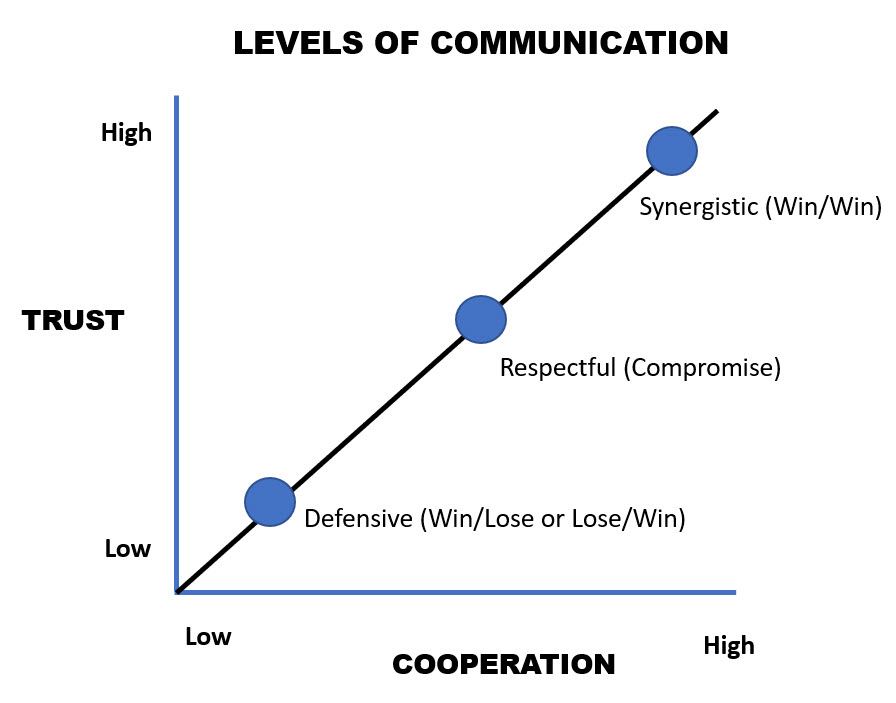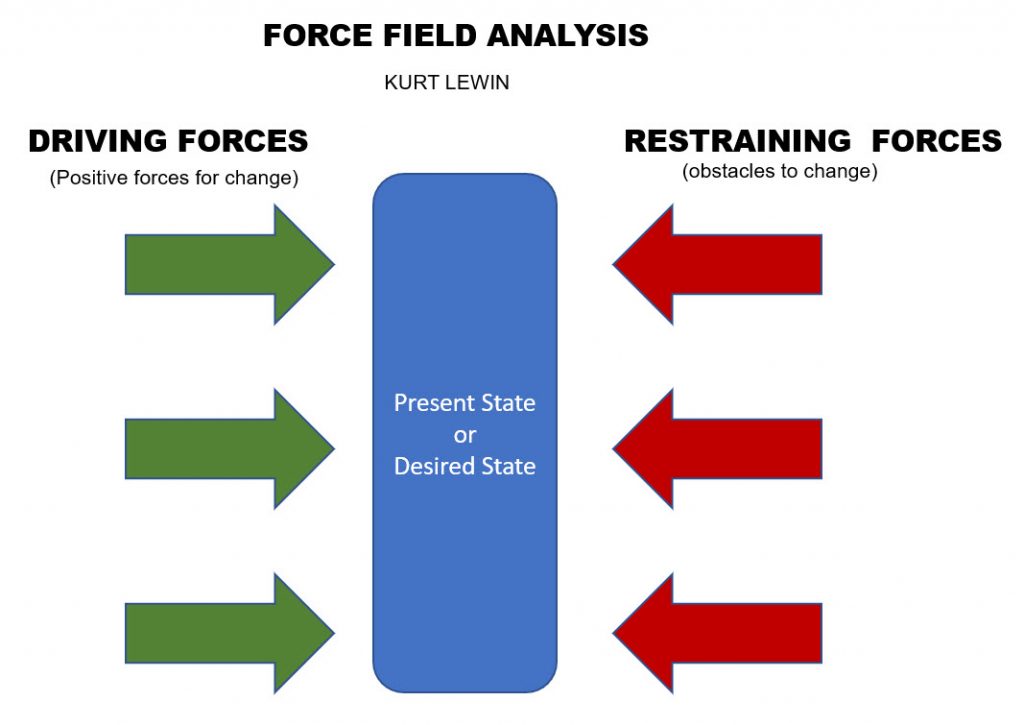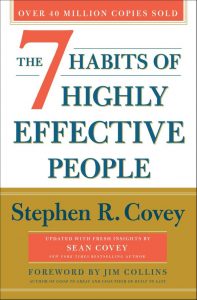The 7 Habits of Highly Effective People, by Stephen Covey
Publisher: Simon & Schuster (1989)
ISBN-13: 978-0743269513
Buy: The 7 Habits of Highly Effective People at Amazon
Rating: ⭐⭐⭐⭐⭐
Table of Contents
Habit 6: Synergize
from The 7 Habits of Highly Effective People by Stephen Covey (1989)
3 Main Ideas
- Synergy occurs when two or more independent things combine into a whole that is greater than the sum of its individual parts. Together, we are stronger and can achieve more and greater things than we could achieve by ourselves as individuals. The whole becomes greater than the sum of its individual components. With synergy, one plus one equals three or more.
- Valuing the mental, emotional, & psychological differences between people is the essence of synergy. The key to valuing differences is to realize that all people see the world not as it is, but as they are. The essence of synergy is to value differences, build on strengths, and compensate for weaknesses. This opens up new insights, paradigms, perspectives that bring about new innovations, options, and alternatives that could not easily have been achieved separately.
- Believe in a third way or alternative. There is almost always a third alternative. This is not the same as compromise. Buddhism calls this “the middle way.” Middle in this sense does not mean compromise; it means higher, like the apex of the triangle. (352). If you operate with a Win/Win philosophy, with openness and creativity, and really seek to understand, you will most likely be able to discover new possibilities and solutions that work better for all parties involved.
5 Key Takeaways
- Synergy is the combination of all the other habits to create something that is bigger than the sum of its individual components. Through creative collaboration, synergy allows for new possibilities, arrangements or solutions that are better than those that would have occurred if each person operated individually. It occurs when “one plus one equals three or more and the whole is greater than the sum of its parts”
- Believe in a third way. Most of the time (not all the time), you can find synergistic answers to complex problems. A third way is not the same thing as compromise, which only produces a low form of Win/Win. Synergy requires you to believe in a higher outcome or alternative, one that produces transformation among the parties involved, and builds a stronger, more trust-filled relationship. It produces solutions better than any originally proposed, and all parties involved know it. To find third alternatives, you have to believe they exist.
- Compromise means that 1 + 1 = 1. Both parties give and take.
- Synergy means that 1 + 1 may equal 8, 16, or even 1,600
- Conversation and communication is essential to creating synergy. We must learn to communicate with one another….We need to brainstorm, talk through issues, bounce ideas off each other, and go back to the drawing board again and again and again. (368) It requires us to cast aside old scripts and assumptions, and creating new ones, together.
- Strength in Diversity/Difference. Value differences. Everyone has different strengths and weaknesses. Don’t build your emotional life around the weakness of another person. Instead, run with his strengths and try to compensate for his weaknesses. Complement him. (370) To find third alternatives, set your ego aside, and realize that you need the collective intelligence of everyone involved to find the best solution. Every individual is smart in different ways and everyone can contribute. (367)
- Systems Thinking. Synergy is everywhere in nature. If you plant two plants close together, the roots commingle and improve the quality of the soil so that both plants will grow better than if they were separated. (340) As a result, be on the lookout for ways to incorporate and create synergy in your life. Learn to see how nearly everything functions as part of an interconnected system that, when taken together, can generate outcomes far greater than the sum of its parts.
Top Quotes
- [Synergy] means that the whole is greater than the sum of its parts. It means that the relationship that the parts have to each other is a part in and of itself. It is not only a part, but the most catalytic, the most empowering, the most unifying, and the most exciting part. (340)
- Insecure people think that all reality should be amenable to their paradigms. They have a high need to clone others, to mold them over into their own thinking. They don’t realize that the very strength of the relationship is in having another point of view. Sameness is not oneness; uniformity is not unity. Unity, or oneness, is complementariness, not sameness. Sameness is uncreative… and boring. The essence of synergy is to value the differences. (354)
- And unless we value the differences in our perceptions, unless we value each other and give credence to the possibility that we’re both right, that life is not always a dichotomous either/or, that there are almost always third alternatives, we will never be able to transcend the limits of that conditioning. (358)
- It is effectiveness in an interdependent reality – it is teamwork, team building, the development of unity and creativity with other human beings. (364)
- The relationship of the parts is also the power in creating a synergistic culture inside a family or an organization. The more genuine the involvement, the more sincere and sustained the participation in analyzing and solving problems, the greater the release of everyone’s creativity, and of their commitment to what they create. (364)
Summary
Synergy simply means that we are stronger together. By communicating, cooperating, and combining our various differences together, we are able to achieve more things together than we could separately or alone. Synergy is the habit of teamwork, team building, creative collaboration, and the development of unity and creativity with other people.
Synergy is everywhere in nature. If you plant two plants close together, the roots commingle and improve the quality of the soil so that both plants will grow better than if they were separated. (340)
For instance, in a marriage based on synergy, the two partners can build their relationship on a foundation of trust, love, and respect. They might even have complementary strengths and weaknesses. Any obstacles faced will be faced as a team. They’re not on opposite sides of the problem, but rather together on one side.
Their synergy as a team will enable them to deeply understand the challenges they face, and they will be better equipped to come up with a third alternative to solve them. Their habit of synergy enables them to grow and build together in such a way that might not have been possible if they were separated. The relationship also grows stronger as a result of this philosophy of creative collaboration.
You can also have internal synergy within yourself. By reconciling the logical and creative parts of your persona, by genuinely seeking to understand through practicing empathic communication, by being open to differences and seeking to create win/win outcomes, you can create a virtuous cycle of opportunities for synergy, even in the most hostile of environments.
Synergy is present throughout nature. Everything is connected. Animals, Plants, Forests, Lakes, Oceans, People, Families, Teams, Organizations, Cities, Countries, Weather, Climate. We all form a part of a system that is interdependent. Learn to develop ways of thinking in terms of systems; how everything is part of an interconnected system that can generate impressive outcomes far greater than their individual components.
Habit 6: Synergize
- The essence of synergy is to value differences—to respect them, to build on strengths, to compensate for weaknesses. (341)
- You begin with the belief that parties involved will gain more insight, and that the excitement of that mutual learning and insight will create a momentum toward more and more insights, learnings, and growth. (341)
- Then whole new worlds of insights, new perspectives, new paradigms that ensure options, new alternatives are opened up and thought about. (345)
Synergy & Communication

- Low Levels of Communication
- Lowest level of communication
- Low-trust situations
- Characterized by defensiveness, protectiveness & legalistic language
- Medium Levels of Communication
- The level where fairly mature people interact
- Respectful communication
- People communicate politely, but not empathically; want to avoid ugly confrontations
- Intellectual & respectful understanding, but not really looking at deeper paradigms or assumptions, or to become open to new possibilities.
- Creative possibilities are not opened up
- High Levels of Communication
- High-trust situations
- Logical and emotional communication that values differences
- Characterized by trust, empathy, and a genuine desire to understand and collaborate
- Desire to achieve high-impact Win/Win outcomes
- In interdependent situations compromise is the position usually taken. Compromise means that 1 + 1 = 1. Both give and take. The communication isn’t defensive or protective or angry or manipulative; it is honest and genuine and respectful. But it isn’t creative or synergistic. It produces a low form of Win/Win. (349)
- Wilbur and Orville Wright would have never invented the airplane without a great deal of discussion and thorough valuing of each other’s differences. Shortly before his death, Wilbur made the statement that “nearly everything that was done in our lives has been the result of conversations, suggestions, and discussion between us.” (368)
Synergy: The Third Alternative (Way of Interaction)
- Synergy means that 1 + 1 may equal 8, 16, or even 1,600. The synergistic position of high trust produces solutions better than any originally proposed, and all parties know it. (349)
- Ideal Environment for Synergy:
- High emotional bank account (ie. high levels of trust)
- Thinking Win/Win
- Seeking first to understand
- Buddhism calls this “the middle way.” Middle in this sense does not mean compromise; it means higher, like the apex of the triangle. (352)
- It is a more effective solution than comprise because it builds P and PC
- Synergy turns a transaction into a transformation; both parties get what they really want and build their relationship in the process.
Negative Synergy
- Insecure people who aren’t interested in listening , and only want to manipulate others, create negative synergy.
- Left Brain thinking alone will be inadequate to solve problems that require a great deal of creativity. Life isn’t only logical, but also emotional.
- Creating synergy requires a combination of left and right brain thinking
- Left Brain: logical, verbal, analytical
- Right Brain: artistic, intuitive, imaginative, visual
Valuing the Differences
- Valuing the mental, emotional & psychological differences between people is the essence of synergy.
- The key to valuing those differences is to realize that all people see the world, not as it is, but as they are. (357)
- Valuing the differences is important because other people’s differences and experiences add to your knowledge about the world, to your understanding of reality [This is why travel is usually such an enlightening activity]
- And unless we value the differences in our perceptions, unless we value each other and give credence to the possibility that we’re both right, that life is not always a dichotomous either/or, that there are almost always third alternatives, we will never be able to transcend the limits of that conditioning. (358)
Force Field Analysis
- Sociologist Kurt Lewin, “Force Field Analysis” Theory:
- The current level of performance or being is the state of equilibrium between driving forces (that encourage upward movement) and restraining forces (that discourage upward movement)
- Driving Forces: positive, reasonable, logical, conscious, economic
- Restraining Forces: negative, emotional, illogical, unconscious, social,/psychological

- Synergy creates “an atmosphere in which it is safe to talk about these forces. You unfreeze them, loosen them up, and create new insights that actually transform those restraining forces into driving ones” (361)
- Synergy uses
- the motive of Habit 4: Think Win/Win
- Skills of Habit 5: Seek First to Understand, Then to be Understood
- Interaction of Habit 6: Synergize
- Outcomes of using Synergy:
- New goals, shared goals are created
- Upward movement and momentum for the whole enterprise, organization, partnership, or relationship
- A new culture is created centered around shared humanity & empowerment
- New, fresh thinking, new alternatives, new opportunities
All Nature is Synergistic
- Everything is related to everything else (ecology)
- Nearly everything is related and interconnected.
- You can also have synergy within yourself (ie. within your Circle of Influence):
- by respecting both the analytical side and the creative side of your own nature.
- Value and use the difference between them to catalyze your own creativity
- even in the midst of a very adversarial environment.
- Sidestep negative energy; don’t take insults personally; look for the good in others, and use that good, as different as it may be, to improve your point of view and widen your perspective.
- by being courageous in interdependent situations.
- Be open; express your ideas, feelings, opinions, and experiences in a way that encourages other people to be open and vulnerable too.
- valuing the difference in other people.
- You simply affirm their value; even if you don’t agree with them.
- Seek to understand their point of view
- by respecting both the analytical side and the creative side of your own nature.
Getting to Synergy
- Define the problem or opportunity.
- Their way (seek first to understand the ideas of others).
- My way (seek to be understood by sharing your ideas).
- Brainstorm (create new options and ideas).
- High way (find the best solution).
How to Apply Habit 6
- Identify a situation in which you desire greater teamwork and synergy.
- What conditions would need to exist to support synergy?
- What can you do to create those conditions? (366)
- The next time you have a disagreement or confrontation with someone, attempt to understand the concerns underlying that person’s position. Address those concerns in a creative and mutually beneficial way. (366)
Recommended Reading
Thinking in Systems by Donella H. Meadows (2008)
Read the whole series
Overview: 7 Habits of Highly Effective People
Habit 1: Be Proactive
Habit 2: Begin With the End in Mind
Habit 3: Put First Things First
Habit 4: Think Win/Win
Habit 5: Seek First to Understand, Then to Be Understood
Habit 6: Synergize
Habit 7: Sharpen the Saw
Have you read this book? What did you think? Share your thoughts and ideas with me!
If you found this summary helpful, just click here to share it!
